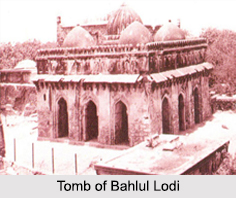 Located in the historic settlement of Chirag Delhi, within the fort walls of the Jahapanah city, the tomb of Bahlul Lodi was built by Sikander Lodi, son and successor of Bahlul Lodi after the demise of his father in July 1489 A.D. Bahlul Lodi"s reign was from 1451 to 1489 A.D. and he was the emperor of the Delhi Sultanate and the founder of the Lodi Dynasty.
Located in the historic settlement of Chirag Delhi, within the fort walls of the Jahapanah city, the tomb of Bahlul Lodi was built by Sikander Lodi, son and successor of Bahlul Lodi after the demise of his father in July 1489 A.D. Bahlul Lodi"s reign was from 1451 to 1489 A.D. and he was the emperor of the Delhi Sultanate and the founder of the Lodi Dynasty.
Architecture of Tomb of Bahlul Lodi
The grave of Bahlul Lodi is a simple octagonal structure with three arched openings on all sides bearing inscriptions from the Holy Quran. The architecture of the tomb of Bahlul Lodi is in Afghan style and is constructed in rubble masonry. The tomb"s roof is crowned by five domes and the central is fluted. The tomb chamber has been modernized at various times and currently is surmounted by a dome of red sandstone surrounded by a broad dripstone. Some of its features are similar to the Khizri mosque at Nizam ud Din, a gold cup hangs over the grave.
A unique architectural feature of that period is the central column, which springs from four monolithic stone columns. Each of its four facades is broken by three archways supported on red sandstone columns and their spandrels are ornamented with medallions. The details of the sandstone decoration are all Hindu. The arches are also decorated with inscriptions incised in plaster.
Repaired and restored back in 2005, currently the tomb is under the protection of the Archaeological Survey of India and is a heritage site.
Visiting Information on Tomb of Bahlul Lodi
The nearest railway station from the tomb is at a distance of about 15 km and the Indira Gandhi International Airport is at a mere distance of 14 km from the tomb.
This article is a stub. You can enrich by adding more information to it. Send your Write Up to content@indianetzone.com.



















